Strait of Hormuz is Iran’s Trump Card Against US Oil Sanctions
Here are Iran’s previous confrontations in the Gulf, military capabilities and the context of the latest threat.

advertisement
The commander of Iran's Revolutionary Guards said last week that Tehran would block all exports through the Strait of Hormuz in the Gulf if countries heed US calls to stop buying Iranian oil from November.
A fifth of global oil consumption passes through the Strait from Middle East crude producers to major markets.
Outlined below are previous confrontations in the Gulf involving Iran, the military capabilities of the various parties and the diplomatic context of the latest threats:
Past Actions
Iran cannot legally close the waterway unilaterally because part of it is in Oman’s territorial waters.
However, ships pass through Iranian waters, which are under the responsibility of Iran's Islamic Revolutionary Guards Navy.
In 2016, the Guards interrogated and held US sailors overnight after they entered Iranian territorial waters elsewhere in the Gulf.
A year earlier, Iran fired shots at a Singapore-flagged tanker which it said damaged an Iranian oil platform and held a container ship and its crew for a week over a debt dispute after diverting it with patrol boats in the Strait. In 2007, Iran detained British sailors further north in the Gulf.
The deputy head of IRGC, Hossein Salami said in 2014 that Iran could use its cruise and ballistic missiles and drones, mines, speedboats, and missile launchers in the Gulf area to confront the United States.
In 2015, the Guards staged a drill, shown on state television, in which a replica of a US aircraft carrier was destroyed with missiles and speed-boats loaded with explosives while the guards practiced laying mines in the Strait.
The US navy has said that from January 2016 to August 2017 there was an average of 2.5 “unsafe” or “unprofessional” interactions per month between US Navy and Iranian maritime forces, including an Iranian drone flying near a US Navy warplane and Iranian military boat sailing close to a US Navy vessel. Tehran has accused US forces of provocation.
“Their security and the security of their interests in the region are in our hands” the Guards' Salami said this year, although the number of incidents has dropped in recent months.
In 1988, a US frigate struck an Iranian mine, blowing a hole in its hull and breaking its keel, the US Office of Naval Intelligence (ONI) said. The United States destroyed two Iranian oil terminals, sank an Iranian warship and damaged another in response, the ONI said.
Military Balance
The US Fifth Fleet, based in Bahrain, is tasked with protecting commercial ships in the area. US officials have said closing the Strait would be crossing a "red line" and have pledged to take action to reopen it.
Western navies also stage military exercises in the Gulf and Arab states across the Gulf from Iran, particularly Saudi Arabia and the UAE, have high-tech naval capacities.
An ONI report said last year that Iran's Guards' naval doctrine was "based on speed, numbers, stealth, survivability, and lethality" and that it had aquired fast attack craft, small boats, anti-ship cruise missiles and mines.
The US has said it would use minesweepers, warship escorts and potentially air strikes to protect the free flow of commerce but reopening the Strait could be a lengthy process especially if the Guards laid mines.
Michael Connell, head of the Iran programme with US non-profit research body CNA, said of all Iran's capabilities, mines were probably the one that caused the most concern. He also said a misjudged incident which would trigger direct fire was a more likely scenario than a blockade of the Strait.
"I would be less worried about a bolt out of the blue attempt to close the Strait and more worried about stumbling into a conflict," he said.
Negotiating Tactic?
Iranian officials differ over the significance of the latest threat to close the Strait.
"If we come to that point of not being able to export any oil, we will surely close the waterway."
Another official, who like the first declined to be named because of the sensitivity of the matter, placed the threat in the context of talks with world powers on the future of the nuclear deal.
"The Strait issue gives Iran an upper hand in the talks. Everyone should know that Iran cannot be pressured," the second senior Iranian government official said. "Iran has never closed the waterway ... even under the worst conditions and mounted pressure on the country."